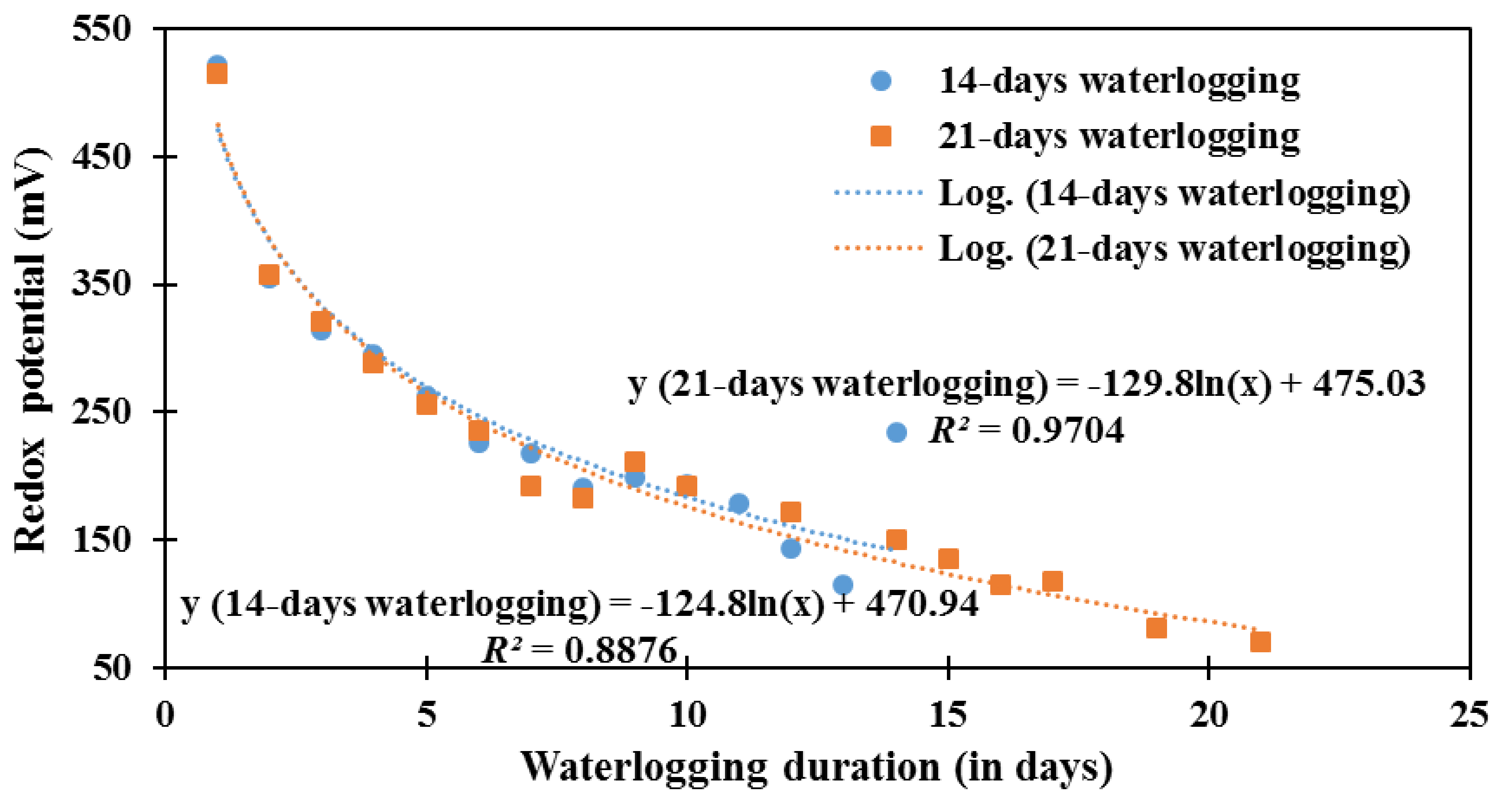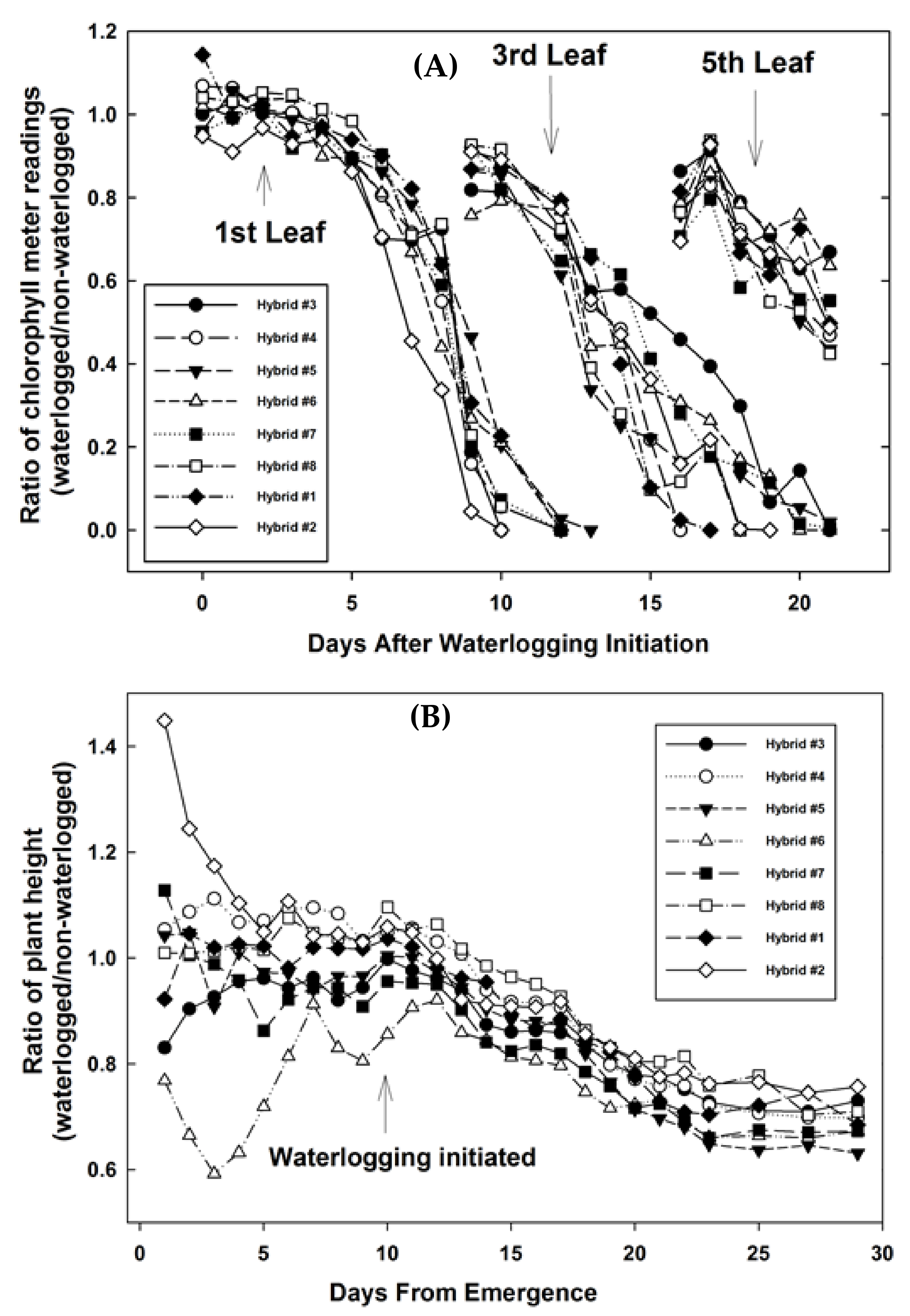Screening Corn Hybrids for Soil Waterlogging Tolerance at an Early Growth Stage
Abstract
:1. Introduction
2. Materials and Methods
2.1. Greenhouse Experiment
2.2. Soil and Plant Measurements
2.3. Statistical Analysis
3. Results and Discussion
3.1. Soil Conditions during Waterlogging
3.2. Stomatal Conductance
3.3. Chlorophyll Meter Readings
3.4. Plant Height and Number of Mature Leaves
3.5. Shoot and Root Biomass
4. Conclusions
Author Contributions
Funding
Conflicts of Interest
References
- Jamison, V.; Peters, D. Slope length of claypan soil affects runoff. Water Resour. Res. 1967, 3, 471–480. [Google Scholar] [CrossRef]
- Anderson, S.; Gantzer, C.; Brown, J. Soil physical properties after 100 years of continuous cultivation. J. Soil Water Conserv. 1990, 45, 117–121. [Google Scholar]
- Motavalli, P.; Anderson, S.; Pengthamkeerati, P. Surface compaction and poultry litter effects on corn growth, nitrogen availability, and physical properties of a claypan soil. Field Crop. Res. 2003, 84, 303–318. [Google Scholar] [CrossRef]
- Wiebold, W.J. Crop Plant Response to Flooding; integrated pest and crop management newsletter. University of Missouri Extension: Columbia, MO, USA, 2015. Available online: https://ipm.missouri.edu/IPCM/2015/6/Crop-Plant-Response-to-Flooding (accessed on 1 July 2016).
- Luce, G.A. Unprecedented Rainfall, Flooding and Impact on Wheat and Cover Crops; University of Missouri Extension: Columbia, MO, USA, 2015; Available online: https://ipm.missouri.edu/IPCM/2015/6/Crop-Plant-Response-to-Flooding/ (accessed on 1 July 2016).
- Bailey-Serres, J.; Lee, S.C.; Brinton, E. Waterproofing crops: Effective flooding survival strategies. Plant Physiol. 2012, 160, 1698–1709. [Google Scholar] [CrossRef] [PubMed]
- Cubasch, U.; Meehl, G.; Boer, G.; Stouffer, R.; Dix, M.; Noda, A.; Senior, C.; Raper, S.; Yap, K. Projections of Future Climate Change. In Climate Change 2001, The Scientific Basis: The IPCC WG1 Third Assessment Report; Houghton J., T., Ding, Y., et al., Eds.; Cambridge University Press: Cambridge, UK, 2001; pp. 526–582. [Google Scholar]
- Drew, M.C. Oxygen deficiency and root metabolism: Injury and acclimation under hypoxia and anoxia. Annu. Rev. Plant Biol. 1997, 48, 223–250. [Google Scholar] [CrossRef] [PubMed]
- Geigenberger, P. Response of plant metabolism to too little oxygen. Curr. Opin. Plant Biol. 2003, 6, 247–256. [Google Scholar] [CrossRef]
- Ren, B.; Zhang, J.; Dong, S.; Liu, P.; Zhao, B. Root and shoot responses of summer maize to waterlogging at different stages. Agron. J. 2016, 108, 1060–1069. [Google Scholar] [CrossRef]
- Bradford, K.J.; Hsiao, T.C. Stomatal behavior and water relations of waterlogged tomato plants. Plant Physiol. 1982, 70, 1508–1513. [Google Scholar] [CrossRef]
- Steffens, D.; Hutsch, B.; Eschholz, T.; Losak, T.; Schubert, S. Water logging may inhibit plant growth primarily by nutrient deficiency rather than nutrient toxicity. Plant Soil Environ. 2005, 51, 545. [Google Scholar] [CrossRef]
- Habibzadeh, F.; Sorooshzadeh, A.; Pirdashti, H.; Modarres-Sanavy, S.A.M. Alleviation of waterlogging damage by foliar application of nitrogen compounds and tricyclazole in canola. Aust. J. Crop Sci. 2013, 7, 401. [Google Scholar]
- Terazawa, K.; Maruyama, Y.; Morikawa, Y. Photosynthetic and stomatal responses oflarix kaempferi seedlings to short-term waterlogging. Ecol. Res. 1992, 7, 193–197. [Google Scholar] [CrossRef]
- Wang, W.; Wang, C.; Sardans, J.; Tong, C.; Jia, R.; Zeng, C.; Peñuelas, J. Flood regime affects soil stoichiometry and the distribution of the invasive plants in subtropical estuarine wetlands in china. Catena 2015, 128, 144–154. [Google Scholar] [CrossRef]
- Board, J. Waterlogging effects on plant nutrient concentrations in soybean. J. Plant Nutr. 2008, 31, 828–838. [Google Scholar] [CrossRef]
- Robertson, D.; Zhang, H.; Palta, J.A.; Colmer, T.; Turner, N.C. Waterlogging affects the growth, development of tillers, and yield of wheat through a severe, but transient, n deficiency. Crop Pasture Sci. 2009, 60, 578–586. [Google Scholar] [CrossRef]
- Wu, J.-D.; Li, J.-C.; Wei, F.-Z.; Wang, C.-Y.; Zhang, Y.; Sun, G. Effects of nitrogen spraying on the post-anthesis stage of winter wheat under waterlogging stress. Acta Physiol. Plant. 2014, 36, 207–216. [Google Scholar] [CrossRef]
- Ritter, W.; Beer, C. Yield reduction by controlled flooding of corn. Trans. Asae 1969, 12, 46–47. [Google Scholar]
- Zaidi, P.H.; Rafique, S.; Rai, P.; Singh, N.; Srinivasan, G. Tolerance to excess moisture in maize (Zea mays L.): Susceptible crop stages and identification of tolerant genotypes. Field Crop. Res. 2004, 90, 189–202. [Google Scholar] [CrossRef]
- Fausey, N.; McDonald, M. Emergence of inbred and hybrid corn following flooding. Agron. J. 1985, 77, 51–56. [Google Scholar] [CrossRef]
- Nielsen, R.L. Effects of Flooding or Ponding on Corn prior to Tasseling. Corny News Network. Available online: http://www.Kingcorn.Org/news/timeless/pondingyoungcorn.html (accessed on 20 September 2016).
- Wu, J.-D.; Li, J.-C.; Wang, C.-Y.; Wei, F.-Z.; Zhang, Y.; Wu, W.-M. Effects of spraying foliar nitrogen on activities of key regulatory enzymes involved in protein formation in winter wheat suffered post-anthesis high temperature and waterlogging. J. Foodagric. Environ. 2013, 11, 668–673. [Google Scholar]
- Subbaiah, C.C.; Sachs, M.M. Molecular and cellular adaptations of maize to flooding stress. Ann. Bot. 2003, 91, 119–127. [Google Scholar] [CrossRef]
- Torbert, H.; Hoeft, R.; Vanden Heuvel, R.; Mulvaney, R.; Hollinger, S. Short-term excess water impact on corn yield and nitrogen recovery. J. Prod. Agric. 1993, 6, 337–344. [Google Scholar] [CrossRef]
- Zaidi, P.; Maniselvan, P.; Srivastava, A.; Yadav, P.; Singh, R. Genetic analysis of water-logging tolerance in tropical maize (Zea mays L.). Maydica 2010, 55, 17–26. [Google Scholar]
- Abendroth, L.J.; Elmore, R.W.; Boyer, M.J.; Marlay, S.K. Corn Growth and Development; Iowa State University Extension Publication 1009: Ames, IA, USA, 2011. [Google Scholar]
- Nathan, M.; Stecker, J.; Sun, Y. Soil Testing in Missouri: A Guide for Conducting Soil Tests in Missouri; University of Missouri: Columbia, MO, USA, 2006. [Google Scholar]
- Vepraskas, M.; Cox, J. Redox potential measurements; NC State University: Chapel Hill, NC, USA, 2002; pp. 1–17. Available online: http://citeseerx.ist.psu.edu/viewdoc/download?doi=10.1.1.630.1755&rep=rep1&type=pdf (accessed on 20 July 2016).
- Sahrawat, K. Fertility and organic matter in submerged rice soils. Curr. Sci. 2005, 88, 735–739. [Google Scholar]
- Husson, O. Redox potential (eh) and ph as drivers of soil/plant/microorganism systems: A transdisciplinary overview pointing to integrative opportunities for agronomy. Plant Soil 2013, 362, 389–417. [Google Scholar] [CrossRef]
- Unger, I.M.; Motavalli, P.P.; Muzika, R.-M. Changes in soil chemical properties with flooding: A field laboratory approach. Agric. Ecosyst. Environ. 2009, 131, 105–110. [Google Scholar] [CrossRef]
- Fageria, N.; Carvalho, G.; Santos, A.; Ferreira, E.; Knupp, A. Chemistry of lowland rice soils and nutrient availability. Commun. Soil Sci. Plant Anal. 2011, 42, 1913–1933. [Google Scholar] [CrossRef]
- Zaidi, P.H.; Rafique, S.; Singh, N. Response of maize (Zea mays L.) genotypes to excess soil moisture stress: Morpho-physiological effects and basis of tolerance. Eur. J. Agron. 2003, 19, 383–399. [Google Scholar] [CrossRef]
- Kögel-Knabner, I.; Amelung, W.; Cao, Z.; Fiedler, S.; Frenzel, P.; Jahn, R.; Kalbitz, K.; Kölbl, A.; Schloter, M. Biogeochemistry of paddy soils. Geoderma 2010, 157, 1–14. [Google Scholar] [CrossRef]
- Chen, H.; Qualls, R.G.; Miller, G.C. Adaptive responses of lepidium latifolium to soil flooding: Biomass allocation, adventitious rooting, aerenchyma formation and ethylene production. Environ. Exp. Bot. 2002, 48, 119–128. [Google Scholar] [CrossRef]
- Jackson, M.B. Root-to-shoot communication in flooded plants: Involvement of abscisic acid, ethylene, and 1-aminocyciopropane-l-carboxylic acid. Agron. J. 1994, 86, 775–782. [Google Scholar] [CrossRef]
- de Souza, T.C.; Magalhães, P.C.; Pereira, F.J.; de Castro, E.M.; Parentoni, S.N. Morpho-physiology and maize grain yield under periodic soil flooding in successive selection cycles. Acta Physiol. Plant. 2011, 33, 1877–1885. [Google Scholar] [CrossRef]
- Wang, X.; Liu, T.; Li, C.; Chen, H. Effects of soil flooding on photosynthesis and growth of Zea mays L. Seedlings under different light intensities. Afr. J. Biotechnol. 2012, 11, 7676–7685. [Google Scholar]
- Zaidi, P.; Maniselvan, P.; Yadav, P.; Singh, A.; Sultana, R.; Dureja, P.; Singh, R.; Srinivasan, G. Stress-adaptive changes in tropical maize (Zea mays L.) under excessive soil moisture stress. Int. Maize Wheat Improv. Cent. 2007, 52, 159–171. [Google Scholar]
- Bin, Y.; Qiujie, D. Ameliorative effects of exogenous active oxygen scavengers on waterlogging injury of maize plants. Acta Agric. Boreali-Sin. (China) 1995, 10, 51–55. [Google Scholar]
- Bragina, T.; Rodionova, N.; Grinieva, G. Ethylene production and activation of hydrolytic enzymes during acclimation of maize seedlings to partial flooding. Russ. J. Plant Physiol. 2003, 50, 794–798. [Google Scholar] [CrossRef]
- Bragina, T.; Drozdova, I.; Alekhin, V.; Ponomareva, Y.V.; Grineva, G. The Rates of Photosynthesis, Respiration, and Transpiration in Young Maize Plants under Hypoxia. Dokl. Biol. Sci. 2001, 380, 482–485. [Google Scholar] [CrossRef] [PubMed]
- Grzesiak, S.; Hura, T.; Grzesiak, M.T.; Pieńkowski, S. The impact of limited soil moisture and waterlogging stress conditions on morphological and anatomical root traits in maize (Zea mays L.) hybrids of different drought tolerance. Acta Physiol. Plant. 1999, 21, 305–315. [Google Scholar] [CrossRef]
- Lizaso, J.I.; Ritchie, J.T. Maize shoot and root response to root zone saturation during vegetative growth. Agron. J. 1997, 89, 125–134. [Google Scholar] [CrossRef]
- Lizaso, J.I.; Melendez, L.M.; Ramirez, R. Early flooding of two cultivars of tropical maize. I. Shoot and root growth. J. Plant Nutr. 2001, 24, 979–995. [Google Scholar] [CrossRef]











| Initial Soil Properties | Average Value (±Standard Deviation) |
|---|---|
| pHs | 6.5 ± 0 |
| Neutralizable acidity (cmolc kg−1) | 0.5 ± 0 |
| CEC (cmolc kg−1) | 12.9 ± 0.5 |
| NO3−-N (mg kg−1) | 7.9 ± 0.2 |
| Organic matter (g kg−1) | 26 ± 1 |
| Bray-1 P (kg ha−1) | 109 ± 1 |
| K (kg ha−1) | 509 ± 18 |
| Exchangeable Ca (kg ha−1) | 4696 ± 177 |
| Exchangeable Mg (kg ha−1) | 375 ± 18 |
| Soil textural class | Silt loam |
| Sand (g kg−1) | 130 ± 0 |
| Silt (g kg−1) | 720 ± 10 |
| Clay (g kg−1) | 160 ± 10 |
| Waterlogging Duration | Days after Waterlogging | |||||
|---|---|---|---|---|---|---|
| 0 | 10 | 13 | 21 | 16 | 21 | |
| Second Leaf | Fourth Leaf | Fifth Leaf | ||||
| -----days---- | ---------------------------------SPAD units------------------------------------ | |||||
| 0 | 45.3 b † | 51.3 a | 49.6 a | 50.8 a | 49.1 a | 50.4 a |
| 14 | 45.9 ab | 27.9 c | 35.0 b | 31.0 c | 38.0 b | 38.5 b |
| 21 | 45.5 ab | 28.5 c | 35.8 b | 11.9 d | 37.9 b | 26.3 c |
© 2019 by the authors. Licensee MDPI, Basel, Switzerland. This article is an open access article distributed under the terms and conditions of the Creative Commons Attribution (CC BY) license (http://creativecommons.org/licenses/by/4.0/).
Share and Cite
Kaur, G.; Zurweller, B.; Motavalli, P.P.; Nelson, K.A. Screening Corn Hybrids for Soil Waterlogging Tolerance at an Early Growth Stage. Agriculture 2019, 9, 33. https://doi.org/10.3390/agriculture9020033
Kaur G, Zurweller B, Motavalli PP, Nelson KA. Screening Corn Hybrids for Soil Waterlogging Tolerance at an Early Growth Stage. Agriculture. 2019; 9(2):33. https://doi.org/10.3390/agriculture9020033
Chicago/Turabian StyleKaur, Gurpreet, Brendan Zurweller, Peter P. Motavalli, and Kelly A. Nelson. 2019. "Screening Corn Hybrids for Soil Waterlogging Tolerance at an Early Growth Stage" Agriculture 9, no. 2: 33. https://doi.org/10.3390/agriculture9020033
APA StyleKaur, G., Zurweller, B., Motavalli, P. P., & Nelson, K. A. (2019). Screening Corn Hybrids for Soil Waterlogging Tolerance at an Early Growth Stage. Agriculture, 9(2), 33. https://doi.org/10.3390/agriculture9020033






